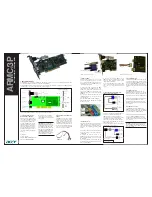
WiSnap User Manual 4.41 05282015-ML
Page 31
1
2
set sys trigger 2
2
4
set sys trigger 4
WARNING: Under no conditions should the voltage on any sensor input exceed 1.2VDC. Permanent damage to the
module will result.
Sensor inputs are rated 1.2VDC maximum. You must use a resistor divider when driving a sensor pin from the other 3V pins
such as RX. A resistor divider network with a minimum of 24K in series and 10K to ground from the UART RX or CTS pin should
be used.
An open drain FET is a good device to tie to the SENSE pin. The threshold is about 500mV. Additional pullup to 1.2VDC may be
used if the circuit has an impedance (due to leakage current) of less than 5Mohms (500mv / 100nA). SENSE 0 to 3 pins that are
not used should be left unconnected.
10.3 Wake on UART
When the module is in sleep mode, the UART itself is disabled. However, wake on UART can be accomplished by connecting
the SENSE pins to the RX data or CTS pin (using the appropriate divider resistors mentioned above).
The WiSnap SuRFBoard has a built in resistor divider connecting SENSE 0 and SENSE 1 to RXD and CTS respectively. This allows
wake on RX and CTS using a 3.3V signal.
WARNING: Do not apply 3.3V directly to SENSE 0 and SENSE 1. Under no conditions should the voltage on any
sensor input exceed 1.2VDC. Permanent damage to the module will result.
NOTE:
On WiSnap SuRFBoard
rev 2
the resistor pack connecting RX and CTS signals is not correctly connected to the
sensors. To wake on UART RX place a jumper from pin 3 on the Evaluation board header to pin 2 on the sensor
header. To wake on UART CTS place a jumper from pin 10 on the Evaluation board header to pin 3 on the sensor
header.
To enable wake on RXD, use
set sys trig 1.
It should be noted that the first (or possibly multiple) byte sent into the module will likely be lost, so the designer should take
care to send a preamble byte to wake up the module before sending valid data bytes. A better way to do this is to use the CTS
input to wake the module, and wait until it is ready to accept data. To enable this, use
set sys trig 2.
10.4 UART Receiver, RTS/CTS Hardware Flow Control
The UART receive buffer is approx. 1500 bytes, and at lower baud rates (less than 115K) the system can send data over TCP/IP
without the need for flow control.
Depending on the frequency and quantity of data begin sent, the
set comm
parameters will optimize Wi-Fi performance by
specifying when the system sends IP packets. To minimize latency and TCP/IP overhead use the flush size or match character
to send data in a single IP packet. In most cases you will want to set the flush timer to a large number to avoid fragmentation.
For high throughput cases increase the UART baud rate, set the flush size to 1460 and flush timer to a large value so full IP
packets are sent.
You can control the packet forwarding 3 ways:
set comm match
<value>
|
<hex>
-
This command sets the match character, where
<value>
is a decimal number from
0 to 127 or a hex number from 0 to 7F. When this configuration option is set, the module sends an IP packet each time
the match character appears in the data. You enter
<value>
either as the decimal (e.g., 13) or hex (e.g., 0xd)
















































